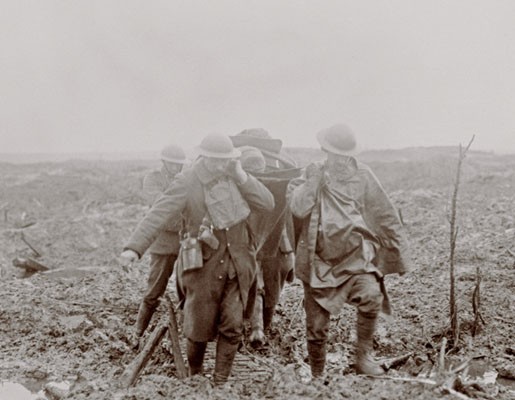
Canadian soldiers carry a wounded comrade through the mud during the Third Battle of Ypres in November 1917.
Inspired by McCrae’s “In Flanders Fields,”
a collection of new essays by prominent
Canadian authors inspires us to remember
There is a fierceness in the air. In and about a quiet area of Belgium and France. In and about pathways and fields, roads of pavement and roads of dust. In and about farms and modest woods that were, at one time, sites of horrific battles at the Western Front.
The fierceness prevails in the smallest graveyards and at the side of towering monuments. It emanates not only from the landscape but from the observer, from the consciousness of those who bear witness, a full century after fighting began.
We can bear witness, long after events have occurred. That is my belief. Details of World War I are still held in the memory of descendants. In the memory of children of soldiers, like my 94-year-old mother, whose father was training in England at the time the war ended in November 1918. My mother’s uncle, who served in the artillery throughout the war, wrote home frequently to his younger brother (my grandfather), warning him not to enlist when he came of age. My grandfather did eventually join the war effort and once witnessed the shameful abuse of a horse while training in England. He despised the abuser ever after, and told the story many times in years to come.
My grandfather’s first cousin suffered from a gas attack during the war and returned home to Belleville, Ont., only to die of lung complications soon afterward. When I think of him, I think of the words of Wilfred Owen from “Dulce et Decorum est.”
Gas! GAS! Quick, boys!…
But someone still was yelling
out and stumbling…
In all my dreams, before my
helpless sight,
He plunges at me, guttering,
choking, drowning.
In my version, my grandfather’s cousin is the one who is yelling out and stumbling. The man I never met, eternally gasping for air, eternally running, not in uniform but in the overalls he’d have worn to the barn every day while he did his chores on the farm at home.
Another of my grandfather’s cousins (a young American who came to Canada to enlist) died at the Somme. He was killed four months after he enlisted, possibly during his first battle. His body was never recovered. I found his name on the wall of the Canadian National Vimy Memorial in France. His photograph is in my family album. His descendants, relatives of my own generation, still mourn.
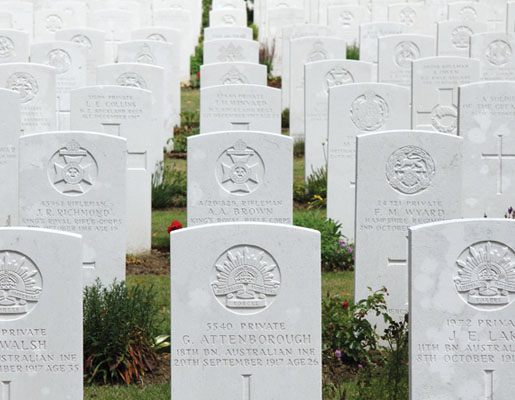
At Hooge Crater Cemetery (right), named for a mine crater blown by the British in July 1915, almost 6,000 Commonwealth servicemen are buried or commemorated. [Eric Harris]
Two of my maternal grandmother’s brothers also went off to war. One, referred to as Uncle Jim by the family, began his pilot training at an airfield near Deseronto, Ont.; his younger brother, Uncle Ted, was underage and kept running away to join up. Each time he did so, my great-grandmother ran after him and had him released. The third time, she gave up. He enlisted, lying about his age (his war documents, copies of which I now own, attest to this), and fought at the Western Front, saving another of our relatives in the midst of battle by hoisting the wounded man—who had been shot in the knee—over his shoulder and carrying him to safety.
I was a grandchild who asked questions.
Where? And how?
And to what end? And why,
in the 21st century, do I
now concern myself with
World War I at all?
My father’s sister told me that one of their older cousins from London, Ont., had gone to war and come home alive, but had “never been right in the head since.” No other information was offered. When I asked for detail, my aunt and my father looked away. It was as if some shameful event had taken place.
In my imagination, these distant and not-so-distant relatives who went off to war are always in motion: digging themselves into trenches; harnessing horses; holding their hands over their ears; hauling and loading the big guns. They swarm, in some sort of otherwise faceless mass, over sodden, eerie landscapes. I relate the few facts I know about them to my children and grandchildren. Small details that have been retained in my own memory. I was a grandchild who asked questions. Where? And how? And to what end? And why, in the 21st century, do I now concern myself with World War I at all?
I ask myself this last question because a disequilibrium exists. A refusal to believe that there was not enough collective will to end the war once it had begun. There is a stubborn refusal on my part to understand how entrenchment was tolerated as the norm while slaughter and sacrifice continued, year after year, with so little ground won by either side.
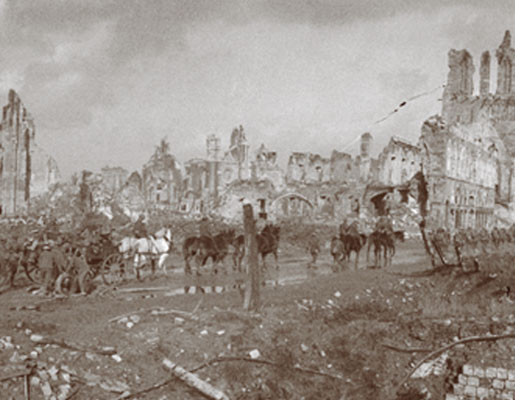
Canadian troops pass through Ypres, Belgium, in November 1917, when the Cloth Hall and St. Martin’s Cathedral were in ruins. [DND/LAC/PA-040271]
In Belgium, there is a museum I wish all Canadians could visit. In Flanders Fields Museum, named after John McCrae’s poem, is located in the reconstructed Cloth Hall of Market Square in Ypres. This museum, opened in 1998, doubles as a documentation centre, and its collections include five thousand books, trench maps, photographs, original documents and periodicals. Visitors are invited to “touch” the war: to listen, to see historical objects of warfare, to watch audiovisual presentations, to learn about medical care, spiritual welfare and even personal accounts of Christmas truces. The viewer, the participant, is confronted in material and philosophical ways, all of which point to a contemplation of war and its opposite, peace.
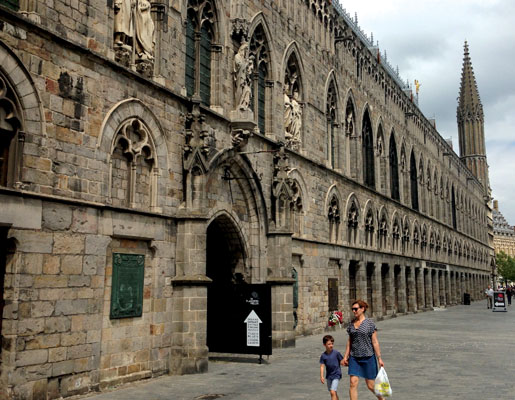
Today, the reconstructed hall hosts the In Flanders Fields Museum. [Eric Harris]
During my two visits to the museum, I heard the words of McCrae read forcefully and aloud, words that drifted through the air, above and around, while visitors examined displays. I heard and read the words of others too. More words from the dead. Lines from Siegfried Sassoon’s poem, “Memorial Tablet”: “I died in hell—(They called it Passchendaele).”
The museum contains, in part, what it records as “eye-witness accounts of the Great War”:
“At the beginning of the war, when someone was killed…we felt it deeply, we went to look. But when we became hardened, we didn’t even change direction when he was lying in front of us. We became hard.” — German soldier
“Then the German behind put his head up again. He was laughing and talking. I saw his teeth glistening against my rifle sight and I pulled the trigger very slowly. He just grunted and crumpled up.” — Captain, 1st Royal Dragoons
“Sometimes, an infantryman would shoot to the left or the right of me, but I knew the enemy would not use me as a target, despite the light which was as strong as day, because I was Father Christmas, and I was carrying the decorated tree.”
— German soldier
“There was not a sign of life of any sort.… Shell hole cut across shell hole…slimy mud, mile after mile as far as the eye could see. It is not possible to set down the things that could be written of the Salient. They would haunt your dreams.” — Canadian private
While I was walking through fields and old trenches and the often muddy landscape of France and Flanders, while pacing around the edge of vast craters, while visiting memorials and cemeteries (the smallest and the largest), while wandering through public and private museums, while staring up at the sky as clouds swept past and the earth seemed to move beneath my feet, I, too, was gathering and creating words. I was thinking of what I wanted to remember and what I wanted to say. I wanted, in some way, to honour the sacrifices that one hundred years ago might have seemed acceptable and unavoidable, though that is not easy to believe today. I experienced a terrible and unrealistic desire to honour every dead soldier; I felt an overwhelming burden to recognize each life taken by that war. But how could this be done in a field that held twelve thousand graves? I tried to notice details on individual stones. The way a maple leaf was carved, a shadow across a marker, an age, a name. And then there were memorials. At Tyne Cot, at the far end of the cemetery, I kept walking and walking around a large semicircular wall, trying to get past the carved names of 34,857 men who had fallen in the Ypres Salient and whose graves are still unknown. How could this many men, lost in the soil, be imagined?
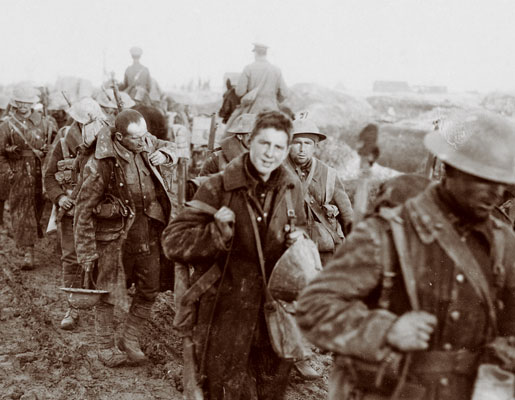
Wet and muddy, Canadian soldiers return from the trenches in 1916. [DND/LAC/PA-000914]
I wanted to ask questions of the dead. I wanted to say, Were you frightened? How did you push down your fear?
I wanted to say to each of the soldiers buried under soil and clay, I am trying to remember for you, because your life was important.
I visited battlefields and knew I could never write enough, remember enough, be present enough.
I wanted to say, Life goes on, but your war is still present.
Indeed, the war is part of everyday life in rural areas of France and Belgium, even in the 21st century. Farmers work their fields in ordinary ways, while tons of World War I debris are coughed up out of the soil each year. Yes, tons. Difficult to believe. I was travelling with another writer—a friend from Alberta—and we were driven by our English friend and guide, Bruce, who pointed out the
evidence, heaped along the edges of country roads. Farmers stack war debris, shrapnel, pieces of metal, digging tools, badges, rusted bayonets, canteens, iron wheels, old wire, all of this awaiting pickup by collectors whose job it is to drive along the roads periodically and haul it away.
Occasionally, a large unexploded shell will surface. This happened at one of the Canadian sites in France just before I visited. The area had been roped off, and French démineurs had promised to come soon to remove the shell. But not all incidents end well. In March 2014, the Ottawa Citizen reported that an armament from World War I had exploded at an industrial site in the former Flanders battlegrounds. Two construction workers were killed and two were wounded. The cause was reported as “a shell or grenade.” “Most armaments that surface,” the article continued, “are destroyed without incident by an army bomb squad.”
One of the places at which I stayed when I was in Belgium was a château, a timbered structure called Kasteelhof ’t Hooghe. Outside the grounds is the Menin Road. Within the property, uneven landscape, gardens, a giant willow tree, a small lake, which is, in fact, an old crater—an historic crater—that over time has filled naturally with water. The entire property is directly on the old front line. The château is a venerable-looking building with trailing vines and a complicated series of angled rooftops and double chimneys. The windows of my second-storey room were hinge-locked, and a hinge-locked door led to a narrow balcony. To open either the windows or the balcony door, I had to pull down on a levered handle, a slow-motion action that was somewhat like drawing down a long iron switch. From my balcony, I could look out through branches and leaves toward the deep crater below. When I turned off the light, my room fell into sudden blackness. Not a glimmer anywhere.
At breakfast, I was told that most of the war souvenirs in the glass cabinets had been dug from the garden. “We have to dig down at least a metre,” the waiter said, “before we find bones and uniforms.”
After leaving the château that morning, I walked along the road to the Hooge Crater Cemetery. The following graves are here: 5,182 British, 105 Canadian, 513 Austrian, 121 New Zealand, 2 British West Indian. Almost 3,600 of those buried are not identified by name.
Our guide, Bruce, arrived at the cemetery to collect me, and we drove on to what was perhaps the quietest place I was to visit in Belgium: Essex Farm Cemetery and Advanced Dressing Station.
No one else was there when we arrived, and I was able to enter one of the bunker-like rooms where John McCrae had looked after wounded and dying men. I sat in a small, squared space and contemplated his work. At the time he was there, the atmosphere would not have been so peaceful.
There were still places to visit. Bruce drove up Canadalaan, which is lined with Canadian maples, and brought us to Hill 62 and a private section of Sanctuary Wood. I wandered slowly along trenches that zigzagged through trees and returned by way of a small on-site museum.
If ever I have seen images that might be able to stop war for all time, it was inside this private museum. Twelve wooden viewing boxes contained stereoscopic views of hundreds of photographs taken during and immediately following the Great War. I stayed for some time, inspecting photos, moving from one viewing box to the next. Two of the views will stay with me forever.
In the first: barren, muddy landscape containing one tall and leafless tree. A full horse’s head and two long legs with hoofs have been blasted upward and droop over the branches of the tree. The remainder of this huge animal’s body is missing.
In the second photo: a soldier’s body is draped in a V over the branch of another dead tree. The soldier’s head is missing.
I stared at these photos. If only, I thought. If only these could be seen by persons who make decisions to wage war, and by those who send others to war. If only these could be seen by those who enlist in wars, and who finance war behind the scenes. If only images and words could be powerful enough. And though the human condition has always included war, we, as artists, must not give up reflecting what armed hostility truly means—using images and photographs and all other forms of art. Using words.
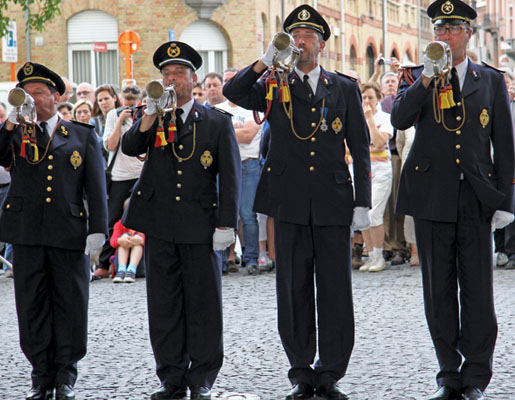
Those who did not return and whose graves are unknown are commemorated in a ceremony at Ypres’ Menin Gate Memorial to the Missing every evening. [Eric Harris]
Two buglers stepped
forward and began to
play the “Last Post” in
perfect harmony. The
crowd listened in silence.
During our final evening in Belgium, we visited the Menin Gate, where every night at 8 p.m. a brief ceremony is held. Two policemen pulled up in a van. They got out, and one stopped traffic in both directions. The other policeman led children who were on bicycles to the side of the road, where they would be able to witness a nightly ritual that has gone on here since 1927, with interruptions only during the Second World War. From the small crowd that gathered—students, cadets, visitors—two buglers stepped forward and began to play the “Last Post” in perfect harmony. The crowd listened in silence. The Menin Gate bears the names of almost 55,000 soldiers who died in Belgium and whose graves are not known. I stood beneath the inscribed names of 6,994 Canadians who are part of this tragic number.
Minutes later, traffic resumed. The cadets marched away. I turned to the side and saw small candles burning along the ledges of the huge monument. There were poppies, too, placed among brief notes and scraps of paper attached to tiny wooden crosses. These scraps of paper contained messages to the dead. One of them read, “You have done miricals for us.” Another was a Canadian message: “From the one daughter of your baby sister.”
No miracle has stopped war. Many of us do still remember.
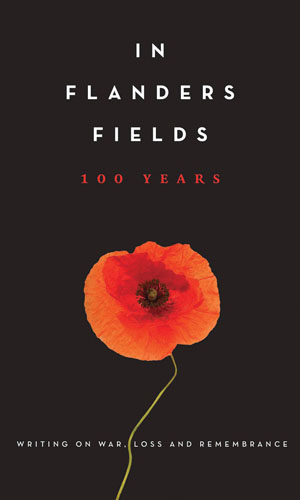
Excerpted from In Flanders Fields: 100 Years.
“Messages to the Living, Messages to the Dead” Copyright © 2015 Itani Writes Inc. Published by Alfred A. Knopf Canada, a division of Penguin Random House Canada Limited. Reproduced by arrangement with the publisher. All rights reserved.
Advertisement





















